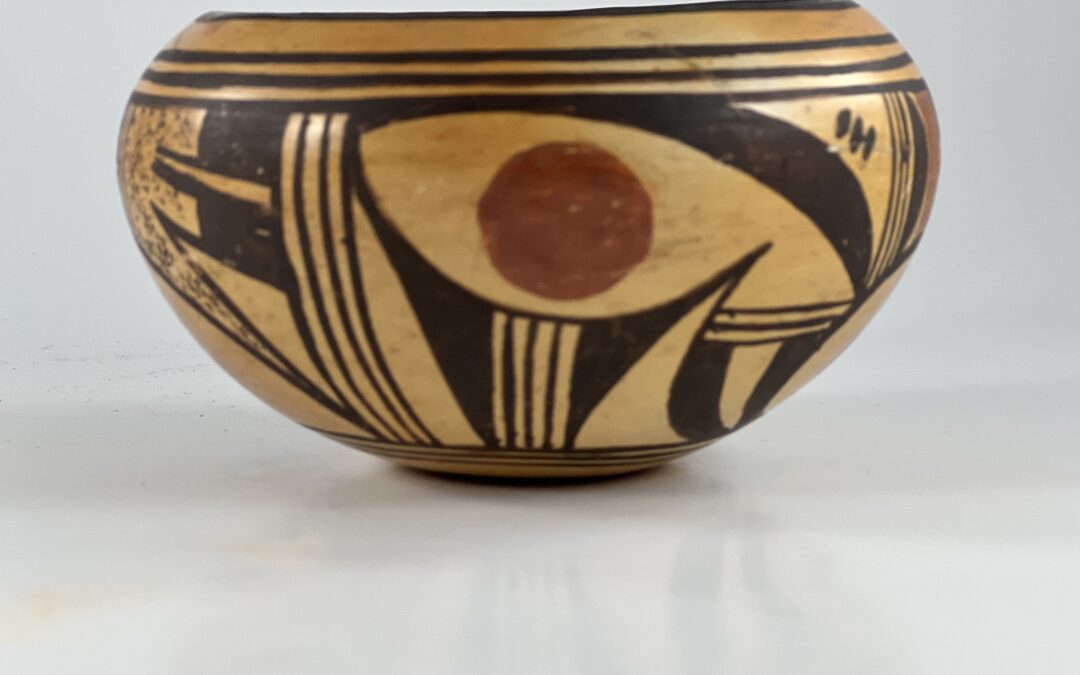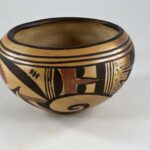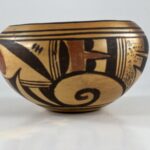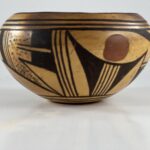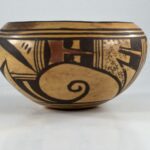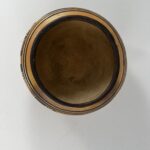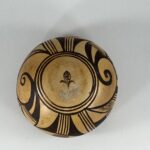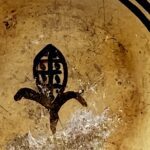This is a well-crafted bowl by a well-known artist (1888-1978) whose lineage is difficult to translate into American standard ancestry, and who thus remains a bit of a mystery. The collection contains three other pots by Lena: a large, faded and repaired bowl with a “man eagle” design (1998-04), a tiny pitcher with a folk-butterfly design (2001-08) and a moderately-sized migration design bowl (2021-17). Given that the first two items are compromised or miniature, I added the migration bowl and pot 2023-09 to the collection to given this potter better representation.
Pot 2023-09 introduces a new element into the Hopi lexicon of design and the pot also displays an unusual organization of design, both indicators of an innovative artist.
Form:
Pots made at Hopi are started by pressing a slab of clay into a concave dish or form (“puki”) with coils of clay added to the edge of the clay disk to create the walls of the vessel. As a result, the bottom of many pots are thicker than their walls. This is not the case with pot 2023-09. The walls of this pot are substantial but not thick and are even throughout, the mark of an exceptional potter. A worn patch on the bottom indicates that the body of the bowl was formed from grey clay with a slip applied to its surface. There is a slight burn mark on one section of the rim, otherwise the slip fired a light tan.
Design:
The design has three thin framing lines at the top and three at the bottom (“two-lane highways.”). While well-drawn, there is some variance in the distance between the lines and the thickness of the lines. The points where the yucca brush was lifted from the surface and then reapplied can be discerned. The top set of framing lines is better-drawn than the lower set. A panel of design fills the 2.25-inch distance between these framing lines.
The design consists of a panel of elements repeated twice. The panels are separated by two sets of 4 parallel lines (three-lane highways) that, like the framing lines, are well-drawn but with some variance of distance between the lines. At the lower center of each panel is a 2.5-inch wide black curlicue that emerges from the lower framing lines and circulates in a large, unpainted, space. Uncoiled it would be 8.5-inches long. Positioned between the apex of the curlicue and the framing lines above is a 1.375-inch high rectangle edged with additional three-lane highways. Based on its left boundary is a wide black hill (“gumdrop”). Set against its curved surface is a wide red element, its center expanding outward into a tall, thin isosceles triangle, thus forming a “clown face” (“Kilroy”) so favored by Nampeyo. The red triangular nose extends across the entire width of this space. On either side of the nose are small black “gumdrops,” followed by small unpainted spaces, followed by black squares or rectangles.
As noted above, the left edge of the Killroy square is bordered by a three-lane highway. At right angle to its lower edge is a short two-lane highway. Below this highway a triangular shape curves to the right forming a big curved, tooth, its upper edge part of the curlicue discussed earlier. The center of this tooth shape is an unpainted space reflecting the bent tooth form of the black element surrounding it.
Then things get more complicated. The outer curve of the large black tooth continues past the end of the two-lane highway to form a 0.5-inch single line. Dropping down in a long curve from this point is a wide swag line whose other end is anchored at the junction between the upper framing lines and the vertical framing lines. From the ends of the 2.75-inch wide swag drop straight lines that slope inward until they touch the lower framing lines when they are only 0.5-inches apart. The result is a somewhat triangular form with a truncated lower point. At the center of this form is a vertical 5-lane highway that runs from the lower framing line to the upper swag edge. Centered in the wide unpainted space above the 5-lane highway and swag is a red ball just under an inch in diameter.
The upped edge of the unpainted space containing the red ball is also curved, starting from the upper-left junction of the vertical and horizontal framing lines and ending at the lower-right junction of the vertical and horizontal framing lines. The element that bridges these points is shaped like a leaf or perhaps a knife blade: narrow to the left and broadening with curved edges as it develops to the right. As it curves downward it leaves the upper right corner of the space open. Into this otherwise unpainted corner Lena has drawn three short lines, like extended quote marks.
Looked at collectively, the curved surfaces of this section of design create an unpainted lens containing the red ball, except that the right point of the lens remains slightly open and the unpainted surface spills through this gap to form a somewhat triangular shape.
We now shift our focus to the design on the right side of the design panel and thus to the right of the red Kilroy /clown element discussed earlier. To the right of the red Kilroy/clown face is a three lane highway. Based on its right wall is a stippled comb with three teeth. The upper two teeth support large, squared-off, black-tiped feathers. The lower projection evolves into a curved blade whose point touches the framing lines below.
Design Analysis:
The design on pot 2023-10 presents contrasting patterns. Some of the design (the long black curlicue and the joyful person with a red head) are surrounded by unpainted surface are thus highlighted, while the remaining the design of interlocking elements (for example the section with the clown/kilroy design) is complex and dense. These two patterns of design do not have equal weight: the highlighted designs seem to break lose from a busy background and this energy attracts my eyes.
The competent but not exact painting defines this bowl as “folk art” and not “fine art.” The abstracted figure of a person with a red head and their arms raised makes me smile every time I see the design. This is not a design I have seen before on pottery from Hopi, and it’s a joyful, attractive image. Only two elements of design are red, but each of these elements is repeated twice on the bowl, thus visually attracting a viewer’s eye across the whole surface of design. The linear leaf shape above the joyful person contrasts with the rounded head below, a strategy also typically used by Nampeyo to add energy to her designs.
Barbara Kramer says that Lena Charlie
“lived on the plaza in Hano. A family member explained that her father was Corn clan, so she was a niece of Nampeyo…If (Nampeyo’s) daughters were not available, she would sometimes carry (an unpainted pot) to Lena Charlie (for painting) (Kramer, 1996: 175 and 139).”
A more extended discussion of Lena Charlie’s genealogy is found in the description of bowl 2021-17.
However, while the painting on bowl 2023-10 is well-done, it is not as controlled as one would expect of Nampeyo at her best. Still, 2023-10 is well-formed and painted with energized and attractive designs that fit the pot. The bowl is a competent piece of American folk art.
Purchased at an online auction of Pook and Pook, 10-27-21, Lot #345. At the time, the auction house was not able to offer provenance. Later I discovered that the bowl had previously been sold by Pook & Pook on 9-11-14, Lot #872 with the description “Hopi-Tewa polychrome bowl ca 1930 attributed to Annie Healing, signed with an ear of corn on interior of bottom.” The attribution of the maker as Annie is an error

